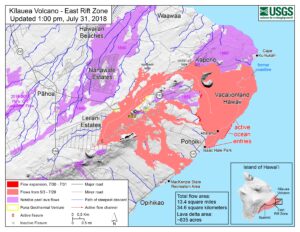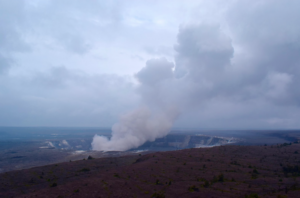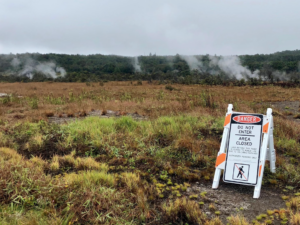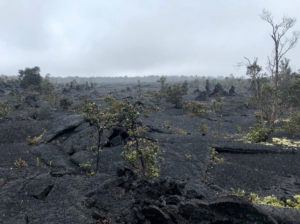By Jessica Duke, MD
Volcano Safety

Kilauea’s lower East Rift Zone (Map courtesy of USGS)
On May 3rd, 2018, the Kilauea volcano on Hawaii’s Big Island erupted from new fissures in the lower East Rift Zone. While there have not been any deaths from this eruption, lava flows have destroyed over 70 homes and forced thousands of people to evacuate the area. In addition to the lava, volcanic gasses are continually being emitted from the fissure eruptions and ash has been intermittently spewing from the vent within Halema’uma’u Crater at Kilauea’s summit.

Halema’uma’u Crater, Kilauea, Hawaii
There are more than 150 active volcanoes in the United States, predominantly in Hawaii, Alaska, and the Cascade Range. An erupting volcano can produce a number of potentially lethal hazards, including fast-moving plumes of hot gas and volcanic matter known as pyroclastic density currents, tsunamis, mudflows, ash, avalanches, gas emissions, steam ejections, and even lightning. Millions of Americans live within the potential footprint of volcanic hazards. If you live near a volcano, following these tips will help keep you and your loved ones safe:
Preparation
- Know your volcano risk. Keep informed of the volcanic activity in your area.
- Plan an evacuation route. Know how to leave your immediate area or region and have a plan for where to go if you have to evacuate. Plan a few alternative routes and destinations so you have options.
- Develop a communication plan. Create a network or phone tree and determine who will help which family members, facilitate communication, take care of children, handle medications, etc. Don’t forget to include your pets in your plans!
- Prepare an evacuation checklist and emergency supplies. Keep goggles and a mask (N95 respirator) in an emergency kit with other essential supplies, including food, water, flashlight, hand radio, first aid kit, prescription medications, clothing, etc.

Sulfur Banks, Volcanoes National Park, Hawaii
Evacuation
- Follow the instructions provided by local officials. If advised to evacuate, do so immediately.
- Wear protective clothing, footwear, goggles, and a mask to shield yourself from ash and dangerous gases. Do not wear contact lenses as this increases your risk of corneal abrasion from volcanic ash.
- Prepare your house. Close all windows, vents, and doors to prevent ash from entering. Place damp towels at any draft sources. Cover electronics and machinery with large tarps to protect them from the sharp crystals in volcanic ash.
- Evacuate to areas where you will not be further exposed to volcanic eruption hazards. Avoid evacuating downstream or downwind from the volcano. Seek shelter indoors if possible.
- Avoid driving if there is ashfall. If you must drive, stay below 35 mph.
- Return only when authorities say it is safe to do so.

Old lava flow, Volcanoes National Park, Hawaii
Check out the International Volcanic Health Hazard Network (https://www.ivhhn.org/information), Volcanoes National Park (https://www.nps.gov/havo/index.htm), and US Geological Survey (https://volcanoes.usgs.gov/volcanoes/kilauea/status.html) websites for the most up to date information.